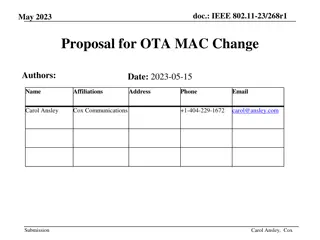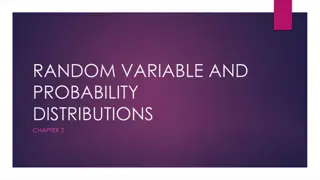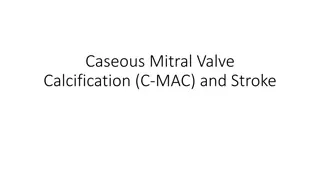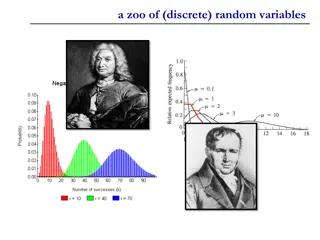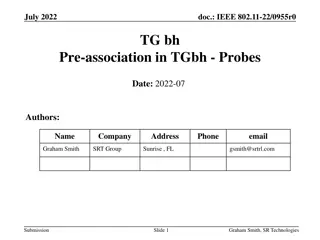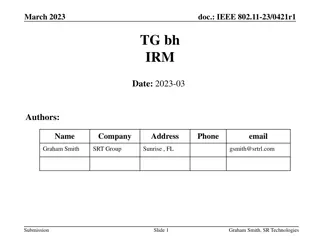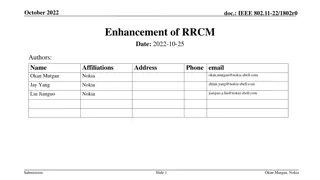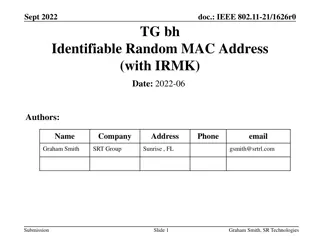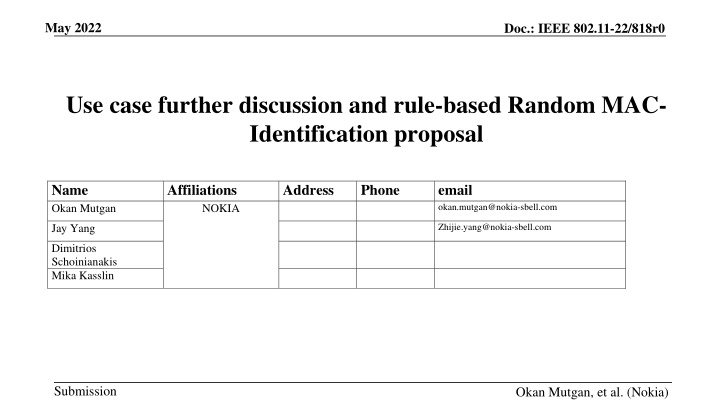
Rule-Based MAC Identification Proposal for IEEE 802.11-22 Standard
Explore a rule-based proposal for identifying devices with random MAC addresses in IEEE 802.11-22 networking to enhance privacy and security. The proposal aims to address privacy concerns related to MAC address tracking and improve identification mechanisms for STAs with Random MAC Addresses (RMAs) in wireless networks.
Download Presentation

Please find below an Image/Link to download the presentation.
The content on the website is provided AS IS for your information and personal use only. It may not be sold, licensed, or shared on other websites without obtaining consent from the author. If you encounter any issues during the download, it is possible that the publisher has removed the file from their server.
You are allowed to download the files provided on this website for personal or commercial use, subject to the condition that they are used lawfully. All files are the property of their respective owners.
The content on the website is provided AS IS for your information and personal use only. It may not be sold, licensed, or shared on other websites without obtaining consent from the author.
E N D
Presentation Transcript
May 2022 Doc.: IEEE 802.11-22/818r0 Use case further discussion and rule-based Random MAC- Identification proposal Name Okan Mutgan Affiliations NOKIA Address Phone email okan.mutgan@nokia-sbell.com Jay Yang Zhijie.yang@nokia-sbell.com Dimitrios Schoinianakis Mika Kasslin Submission Okan Mutgan, et al. (Nokia)
May 2022 Doc.: IEEE 802.11-22/818r0 Background-1 Conventional 802.11 standards are designed in a way that each STA uses its own fixed unencrypted MAC address. This causes a privacy concern such as allowing others to track STAs based on their MAC address. To reduce this privacy risk, using MAC randomization (STAs using random MAC address) became a common technique. Within this context, 11bh focuses on the identification issue on the STA with Random Mac Address (RMA), and several use cases are defined in 332r30: The STA uses a MAC address in the first-time association, and connects to AP. After a while, STA disassociates and wants to connect to the AP with a new MAC address (RMA). In this scenario, how can AP identify the STA with its new MAC address (RMA) privately? Submission
May 2022 Doc.: IEEE 802.11-22/818r0 Background-2 802.11bh D0.1 provides a device ID solution, which covers use cases that the identification happening after association. the identification based on probing(pre-association & post-association) is not addressed. the identification on authentication/(re)association is not addressed. Submission
May 2022 Doc.: IEEE 802.11-22/818r0 Motivation In this document, we would like to have more discussion on the use cases that are widely implemented in current products, and the identification for these use cases needs to be addressed. we propose a rule-based mechanism to identify a STA with its random MAC address. early identification, strong privacy Submission
May 2022 Doc.: IEEE 802.11-22/818r0 Client steering after association(use case 4.8) [Network topology] Gateway connects with AP2,AP3 via wired/wireless backhaul. (STA1) connects with Gateway in the initial association. (STA1) moves from L1 to L2 and the GW(Gateway) detects the RSSI lower than a predefined threshold. (GW) sends a Beacon request frame to instruct STA1 to send a probe request frame to AP2 and AP3 on their operating channel respectively. (AP2, AP3) calculate and report the CSI and RSSI information of the received probe request frame from STA1 to Gateway respectively .[identified probing] (AP2,AP3) respond with probe response to STA1. (STA1) send Beacon report based on the received probe response frame to the GW Note: the Beacon report has the RSSI information of the target APs, but no CSI information of them. (GW) generates the preference list based on AP2 and AP3 s report, send a BTW request frame containing the prefer list(like AP2) to STA1. (STA1) associates with AP2 via FT based on the preference list(like AP2) in the BTW request frame Internet AP3 64CH/5GHz Gateway 36CH/5GHz AP2 64CH/5GHz Move STA1 (L1) STA1 (L2) Submission
May 2022 Doc.: IEEE 802.11-22/818r0 Access control during associating or after association(use case 4.2) During associating After association Resource/memory cost AP needs to allocate all the Resources to these STA without any access permission, which is same to the STAs with all access permissions. User may complain it s AP issue as the STA has already associated with AP but they can t visit internet. ISP will be asked to remote debug it as the user is not aware of the access control on AP side. ? AP doesn t need to allocate Resources(IP address, identifier, STA information ) to these STA without access permission. STA knows that it can t associate with the AP in advance, and it may associate with a neighbor AP to visit internet. User experience In practice Widely used on current AP product for many years. Submission
May 2022 Doc.: IEEE 802.11-22/818r0 Virtual BSSID (use case 4.26) [Network topology] Gateway connects with AP2,AP3 via wired/wireless backhaul. (Precondition1)GW records [STA MAC, BSSID,PWD] information, and can create a unique BSSID for an approved STA. STA also save [BSSID, SSID, PWD] information in its database once it has ever connected with that BSSID. (Precondition2) both AP2 and AP3 have a public BSSID. [STA1] STA1 sends a broadcast probe request frame.[identified probing] [AP2,AP3] calculate and report the CSI and RSSI information of the received probe request frame from STA1 to Gateway respectively. [Gateway] instruct a physical AP(like AP2) to create a private BSSID for that STA. [identified probing] [AP2,AP3] the public BSSID respond with probe response frame. [AP2] create a private BSSID and sent a unsolicited probe response frame to the STA. [STA1] associate with the private BSSID automatically. [pre-association client steering] [Gateway] may move the private BSSID from one physical AP to another one according to STA location.[BSSID move with STA] Internet Gateway AP3 AP2 100CH/5GHz 64CH/5GHz STA1 Submission
May 2022 Rule-based random MAC STA Identification v1 Basic Idea : STA generates RMA and TAG, sends the TAG to AP. AP identifies the STA based on TAG in the next association. In each (current) Association, STA and AP generate same keys based on PTK: STA generates K1 and K2, AP generates K2. (note that these keys are not shared between two parties. They are independently generated at both sides) STA generates its next RMA based on the following formula: RMA_next[:48] = AES-CTR(K1, Nonce||counter, seed) Seed is a random plaintext. Counter = 0. STA generates a TAG (T)based on the following formula (TAG is kind of a signature ): T = HMAC(K2, counter, RMA_next) STA sends the TAG to AP in 4-way HS Msg2 encrypted in KDE. Doc.: IEEE 802.11-22/818r0 In the next Association, AP receives the Probe Request and calculates expected TAG (T ) based on: T' = HMAC(K2, counter, RMA_next), and verifies the STA based on T' == T. Note that the K1 and K2 are deleted at STA side, and K2 and T are stored at AP side after each association. Submission
May 2022 Doc.: IEEE 802.11-22/818r0 Rule-based random MAC STA Identification v1 Example Diagram Prob/Auth/Ass Req/Resp - RMA1 STA1 AP PTK::K2 PTK::K1, K2 4-way Handshake RMA1 (T sent in encrypted Msg2 from STA to AP) RMA2[:48] = AES-CTR(K1, Nonce||counter, seed) T = HMAC(K2, counter, RMA2) Data Connection - RMA1 Disconnect Map T -> STA1 PTK is deleted, K2 stored, T stored. PTK, K1, K2 are deleted Prob/Auth/Ass Req/Resp RMA2 T' =HMAC(K2, counter, RMA2) Verify:: T' == T Delete(K2) 4-way Handshake RMA2 (T sent in encrypted Msg2 from STA to AP) Data Connection RMA2 In the first Association, STA1 is using RMA1 as its MAC address. STA1 and AP generate corresponding keys K1,K2 (keys are not shared, they are generated separately) STA1 generates its next RMA (RMA2) and Tag (T). STA1 sends the Tag to AP in 4-way HS Msg2 encrypted. After disconnection, STA deletes K1,K2. AP stores K2 and T. PTK is also deleted by default. In the second Association, STA1 is using RMA2 as its MAC address. As soon as AP receives the probe request with RMA2, it calculates T', and identifies the STA if the generated tag in the previous association (T) matches the calculated tag, i.e. T == T AP deletes K2 after identification. Submission
May 2022 Doc.: IEEE 802.11-22/818r0 Rule-based random MAC STA Identification v2 Basic Idea : STA and AP generate the same RMA and TAG. STA sends the TAG to AP for verification that both sides generate the same RMA. AP identifies the STA based on RMA in the next association. In each (current) Association, STA and AP generate same keys based on PTK: STA and AP generate K1 and K2. (note that these keys are not shared between two parties. They are independently generated at both sides) STA and AP generate STA s next RMA based on the following formula: RMA_next[:48] = AES-CTR(K1, Nonce||counter, seed) Seed is a random plaintext. Counter=0. STA generates a TAG (T) based on the following formula, and sends the TAG (T) to AP. T = HMAC(K2, counter, RMA_next) AP generates the TAG (T ), and verifies it with the TAG (T), ensuring that both sides generate the same RMA. T = HMAC(K2, counter, RMA_next) == T After verification (T == T), AP maps RMA_next-> STA. In the next Association, AP receives the Probe Request with RMA_next, and identifies the STA immediately (RMA2 -> STA1) Note that the K1 and K2 are deleted at STA side, and K1, K2, T are deleted at AP side after each association. Submission
May 2022 Doc.: IEEE 802.11-22/818r0 Rule-based random MAC STA Identification v2 Example Diagram Prob/Auth/Ass Req/Resp - RMA1 STA1 AP PTK::K1,K2 PTK::K1, K2 4-way Handshake RMA1 (T sent in encrypted Msg2 from STA to AP) RMA2[:48] = AES-CTR(K1, Nonce||counter, seed) T = HMAC(K2, counter, RMA2) RMA2[:48] = AES-CTR(K1, Nonce||counter, seed) T' = HMAC(K2, counter, RMA2) Verify:: T' == T Data Connection - RMA1 Disconnect Map RMA2 -> STA1 PTK, K1, K2, T are deleted PTK, K1, K2, T are deleted. Prob/Auth/Ass Req/Resp RMA2 AP receives RMA2 in probe req and identifies the STA (i.e. STA1) 4-way Handshake RMA2 (T sent in encrypted Msg2 from STA to AP) Data Connection RMA2 In the first Association, STA1 is using RMA1 as its MAC address. STA1 and AP generate corresponding keys K1, K2 (keys are not shared, they are generated separately) STA1 and AP generate next RMA (RMA2) and Tag (T, T ) independently. STA1 sends the Tag to AP in 4-way HS Msg2 encrypted. AP verifies that T ==T. This ensures that both sides generate the same RMA (RMA2). AP maps RMA2 -> STA1 After disconnection, STA and AP delete K1,K2,T. PTK is also deleted by default. In the second Association, STA1 is using RMA2 in probe request as its MAC address, and gets identified immediately. Submission
May 2022 Rule-based random MAC STA Identification v3 Basic Idea : Similar to v2, similar logic. But here, STA and AP generate two RMAs and two TAGs: One RMA (and tag) for probe request frames, one RMA (and tag) for other frames (auth/assoc. etc.). In each (current) Association, STA and AP generate same keys based on PTK: STA and AP generate K1 and K2. (note that these keys are not shared between two parties. They are independently generated at both sides) STA and AP generate two next RMAs (RMA_next for probe request, RMA_next* for other frames such as auth/assoc. etc) based on : RMA_next[:48] = AES-CTR(K1, Nonce||counter, seed), RMA_next*[:48] = AES-CTR(K1, Nonce||counter, seed) Seed is a random plaintext. Counter = 0 for RMA_next, and 1 for RMA_next*. STA generates a TAG (T) based on the following formula, and sends the TAG (T) to AP. T = HMAC(K2, counter, RMA_next) AP generates the TAG (T ), and verifies it with the TAG (T), ensuring that both sides generate the same RMA. T = HMAC(K2, counter, RMA_next) == T After verification (T == T), AP maps RMA_next, RMA_next* -> STA. In the next Association, AP receives the Probe Req with RMA_next and/or other frames with RMA_next*, and identifies the STA immediately (RMA_next, RMA_next* -> STA) Doc.: IEEE 802.11-22/818r0 Submission
May 2022 Doc.: IEEE 802.11-22/818r0 Rule-based random MAC STA Identification v3 Example Diagram Prob/Auth/Ass Req/Resp - RMA1 STA1 AP RMA2[:48] = AES-CTR(K1, Nonce||counter, seed) T' = HMAC(K2, counter, RMA2) RMA2*[:48] = AES-CTR(K1, Nonce||counter, seed) T*' = HMAC(K2, counter, RMA2*) Verify:: T' == T and T*' == T* PTK::K1,K2 PTK::K1, K2 4-way Handshake RMA1 (T, T* sent in encrypted Msg2 from STA to AP) RMA2[:48] = AES-CTR(K1, Nonce||counter, seed) T = HMAC(K2, counter, RMA2) [counter++] RMA2*[:48] = AES-CTR(K1, Nonce||counter, seed) T* = HMAC(K2, counter, RMA2*) Data Connection - RMA1 Disconnect Map RMA2, RMA2* -> STA1 PTK, K1, K2, T are deleted. PTK, K1, K2, T are deleted Prob/Auth/Ass Req/Resp RMA2 AP receives RMA2* from probe req and identifies the STA (i.e. STA1). AP also receives RMA2 from other frames and identifies the STA (i.e. STA1) 4-way Handshake RMA2 (T, T* sent in encrypted Msg2 from STA to AP) Data Connection RMA2 In the first Association, STA1 is using RMA1 as its MAC address. STA1 and AP generate corresponding keys (keys are not shared, they are generated separately) STA1 generates its next RMA (RMA2) and Tag (T). STA1 sends the Tag to AP in 4-way HS Msg1 encrypted. After disconnection, STA deletes K1,K2. AP deleted K1. PTK is also deleted by default. In the second Association, STA1 is using RMA2 as its MAC address. As soon as AP receives the probe request with RMA2, it calculates T', and identifies the STA if the generated tag in the previous association (T) matches the calculated tag, i.e. T == T AP deletes K2 after identification. Submission
May 2022 Doc.: IEEE 802.11-22/818r0 Rule-based random MAC STA Identification v4 Basic Idea : similar idea as v3. But here, we use the device ID from Network Generated Device ID [22/187r2] as input for key K1. In each (current) Association, AP sends Device ID to the STA in 4-way HS Msg3. STA and AP generate two next RMAs (RMA_next for probe request, RMA_next* for other frames such as auth/assoc. etc) based on : RMA_next[:48] = AES-CTR(Device ID, Nonce||counter, seed), RMA_next*[:48] = AES-CTR(Device ID, Nonce||counter, seed) Seed is a random plaintext. Counter = 0 for RMA_next, and 1 for RMA_next*. AP maps RMA_next, RMA2_next* -> Device ID (STA) In the next Association, AP receives the Probe Req with RMA_next and/or other frames with RMA_next*, and identifies the STA immediately (RMA_next, RMA2_next* -> Device ID (STA) STA sends Device ID to AP in 4-way HS Msg2, AP also verifies the STA based on this device ID. AP sends another Device ID to STA in 4-way HS Msg3 for future use. Submission
May 2022 Doc.: IEEE 802.11-22/818r0 Rule-based random MAC STA Identification v4 Example Diagram STA1 Prob/Auth/Ass Req/Resp - RMA1 AP RMA2[:48] = AES-CTR(Device ID1, Nonce||counter, seed) [counter++] RMA2*[:48] = AES-CTR(Device ID1, Nonce||counter, seed) RMA2[:48] = AES-CTR(Device ID1, Nonce||counter, seed) [counter++] RMA2*[:48] = AES-CTR(Device ID1, Nonce||counter, seed) 4-way Handshake RMA1 (Device ID1 sent in encrypted Msg3 from AP to STA) Data Connection - RMA1 Disconnect Map RMA2, RMA2* -> Device ID1 (STA1) Prob/Auth/Ass Req/Resp RMA2 AP receives RMA2* from probe req and identifies the STA (i.e. STA1). AP also receives RMA2 from other frames and identifies the STA (i.e. STA1) 4-way Handshake RMA2 (Device ID1 sent in encrypted Msg2 from STA to AP) (Device ID2 sent in encrypted Msg3 from AP to STA) AP also verifies the STA1 from Device ID1 in 4-way HS Msg2 Data Connection RMA2 Submission
May 2022 Rule-based random MAC STA Identification Further Discussion The generated keys (K1 and K2) can be 128 bits -> high security The keys are never exchanged between STA and AP -> high security (only in v4, device ID is shared between two sides to be used as key) The tag can be 64 bits. The tag is sent between STA and AP -> low overhead The tag is sent encrypted in 4-way HS -> high security Even a third party obtains the tag, it can t identify the user because it does not know how to generate key or the tag-> high security Generated key are (mostly) deleted -> high security. AP identifies the STA from Probe Request -> early identification Both sides generate the RMA separately and independently (in v2,v3,v4)-> high security Doc.: IEEE 802.11-22/818r0 Submission
May 2022 Rule-based random MAC STA Identification Comparison among proposals Doc.: IEEE 802.11-22/818r0 Per Association RMA generation included (STA side/AP side) Total number keys generated (STA side/AP side) Total bits exchanged (extra overhead) e.g. Tag=64 bits, key (device ID) = 128 bits Total number tag checks v1 Yes/No v2 Yes/Yes v3 Yes/Yes V4 Yes/Yes 2/1 2/2 2/2 0/0 64 64 64+64=128 128 (first association) 256 (later associations) 1 1 2 0 Compatible with D0.1 no no no yes Submission
May 2022 Doc.: IEEE 802.11-22/818r0 Reference [1] 802.11bh draft 0.1 [2]11-22-0296-08-00bh-tgbh-proposals.pptx [3] 11-21-0332-30-00bh-issues-tracking.docx Submission
May 2022 Doc.: IEEE 802.11-22/818r0 SP1.1 Do you agree 11bh group should define a solution to address the identification issue in use case 4.8? Submission
May 2022 Doc.: IEEE 802.11-22/818r0 SP1.2 Do you agree 11bh group should define a solution to address the identification issue in associating phase (use case 4.2)? Submission
May 2022 Doc.: IEEE 802.11-22/818r0 SP1.3 Do you agree 11bh group should define a solution to address the identification issue in use case 4.26? Submission
May 2022 Doc.: IEEE 802.11-22/818r0 SP2.1 Do you agree that 11bh group should continue working on the Rule-based random MAC STA Identification v1? Submission
May 2022 Doc.: IEEE 802.11-22/818r0 SP2.2 Do you agree that 11bh group should continue working on the Rule-based random MAC STA Identification v2? Submission
May 2022 Doc.: IEEE 802.11-22/818r0 SP2.3 Do you agree that 11bh group should continue working on the Rule-based random MAC STA Identification v3? Submission
May 2022 Doc.: IEEE 802.11-22/818r0 SP2.4 Do you agree that 11bh group should continue working on the Rule-based random MAC STA Identification v4? Submission
May 2022 Doc.: IEEE 802.11-22/818r0 THANK YOU Submission





